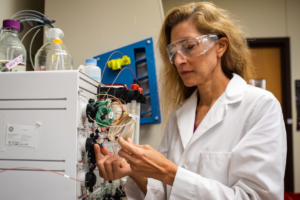We hear a lot of doom-and-gloom about the future.
The world will be too hot, too crowded. There will be too few resources and more competition for them.
We asked University of Texas at Austin researchers for the opposite — the ideas, technologies, policies or combinations that will make it possible for the world to be a better place in the future.
In this second installment of “The Big Question” series, Architecture Professor Steven Moore responds to the question “What in your field could make the world a better place?”
____________________________

Something that might be overlooked in improving the world is affordable housing.
Most of us tend to think that affordable housing is an ethically necessary but unproductive investment. An interdisciplinary group of UT graduate students have, however, demonstrated that homes can be affordable, equitable and contribute to meeting the City of Austin’s aggressive Climate Protection Plan.
Graduate students from architecture, business, law, planning and public policy enrolled in my seminar, “Topics in Sustainable Development,” spent the spring semester of 2011 investigating Austin’s S.M.A.R.T. Housing program. That acronym stands for Safe, Mixed-income, Accessible, Reasonably-priced, and Transit-oriented — all of which are components of sustainable development. Between 2000 and 2010, slightly more than 10,000 S.M.A.R.T. homes were built in the city using funds from a $56 million General Obligation Bond. Although the program is generally considered a successful one, available funds have now been fully committed and economic conditions have grown dismal. Even though the current need for affordable homes in Austin has grown to over 40,000, most supporters have assumed that given deteriorating economic conditions, and the city’s aggressive commitment to climate protection, additional housing would have to wait. After completing an initial study, however, student researchers became convinced that rather than competing with each other for scarce resources, S.M.A.R.T. homes and climate protection are two parts of the same problem and opportunity.
Using GIS (Geographic Information Systems), students determined that if only 50 percent of unused city property were dedicated to affordable homes, as many as 33,000 units could be built. Compared to standard suburban homes, that number of S.M.A.R.T. homes would alone meet 3.4 percent of the total Climate Protection Plan target and reduce carbon emissions by 132,000 tons per year. That reduction is the equivalent of taking 33,000 cars off the road. Simply put, building S.M.A.R.T. homes to meet even more aggressive energy standards would benefit not only the vulnerable families who pay a disproportionate part of their income for energy and water, but all of Austin’s taxpayers, not to mention the environment upon which we all depend.
Although the recommendation by students to renew the S.M.A.R.T. homes program is compelling, they also recognized that changing conditions require new approaches informed by the lessons learned over 10 years. With this in mind, myself and teaching assistant Joshua Lee organized a series of 10 public panel discussions comprised of as many diverse constituencies. In addition to city officials and planners, the panels focused on the seemingly antagonistic interest of housing advocates, the real estate industry and neighborhoods. Although surprising to many, students found that nearly all of the diverse panelists could agree on simplified process to implement a second round of S.M.A.R.T. homes as a part of the city’s new comprehensive plan, Imagine Austin.
The research conducted by students demonstrated two things: First, urban systems that appear to be disconnected are in fact part of a single urban ecology. And second, technological problems are also social ones. When people with competing interests are given the opportunity to engage in public talk about common problems, progress can be made. That is good news!
The report by student researchers is available online.
Dr. Steven A. Moore is the Bartlett Cocke Regents Professor in Architecture in the School of Architecture.



